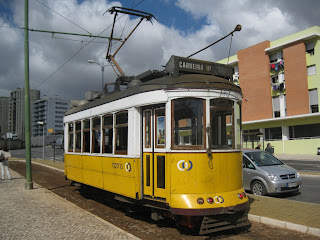 |
| Standard 732 at Belem on route 15 on October 12 2010 |
As noted in the post about the Remodelados Carris built its own four wheel bodies to Brill design until 1940. Its last 'Standards' were 701-735 built from 1935 to 1940 on Maley & Taunton 4 wheel trucks with English Electric DB1 controllers. In 1947 Carris built ten more four wheelers, but to a new boxy design as cars 736-745. In 1987 737, 738, 741-745 were rebodied with Standard bodies from 200 series cars. These cars were equipped for the hilly routes and were double ended, though were converted for one person operation in their latter years.
 |
| The cab of a Standard with DB1 controller with air brake interlock, air brake and hand brakes. |
 |
| The interior, showing how the traditional layout has been retained on the Remodelados, albeit the Standards have 2+2 seating giving a total of 24 |
Several of these 700 cars have survived the modernisation of the fleet with 13 still in stock in October 2010:
- 723 and 726 are Tourist cars 3 and 4, though these were not noticed in use during an October visit - both were at the back of the depot
- 722 and rebodied 745 are 'Christmas Trams' decorated with lights and lettering for Christmas tours - again both were noted at the back of the depot
- 713, 717, 720, 732, 733, 735 and rebodied 741, 742 and 744 are still in service.
 |
| 717 leaves depot for a Private Hire |
During an October visit the following observations were made:
- Thursday 7th- 1030 732 on private hire at Graca
- 1300 732, 741 and 717 left depot on Private hire with tourist car 7. 744 shunted in Depot
- 1605 717 and 735 noted at Estrela
- 1605 732 and 741 noted on route 25 at Estrela for Prazeres
- 1625 733 operated on service 25 from Estrela to City
 |
| 735 and 733 at Prazeres 12 Oct. |
- Monday 11th - 732 operated on service 25 during the morning; 733 during the afternoon
- Tuesday 12th 732 and 735 both on service 25 but swapped for Remodelados; 741 operated route 18 in the afternoon peak and 732 worked to Belem on route 15 before being replaced by 506.
- Wednesday 13th 735 operated on service 25.
 |
| The Standards, such as 735 here, have not been equipped with Pantographs, but still have a full run of the network, despite the preference for Pantographs on the 15, 18 and 25. Note the more style of doors compared to Remodelados 548 in front - and the full complement of lights at the rear end of these double ended cars. |
With their traditional DB1 controllers and air brakes, plus two hand wheel-brakes for the hilly routes these cars seem less popular with drivers - perhaps explaining several switches to more modern cars and some questionable driving standards - that said some drivers drove them with gusto and skill.
Will the Real 741 Please Stand Up
The rebodying of the 1947 cars with older bodies in the 1980s has resulted in the existence of two car 741s. The body removed from 741 was selected for the museum and placed on a spare truck while its equipment was fitted with an older Standard body that makes up the current 741!
 |
| 741's original body on a spare truck in the museum |
 |
| The 'new' 741 amongst the Palms at Rua da Alfândega |



















+307.25.jpg)




++301.25.jpg)























